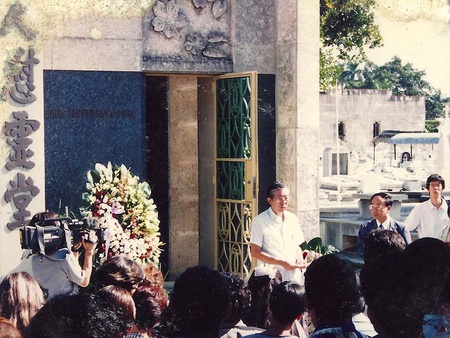Read Part 1 >>
All Issei to a maximum security prison
“After Pearl Harbor, the newspapers from the U.S. wrote about how the Japanese were ‘cruel people’. Here, I never felt any discrimination or disrespect from classmates or neighbours,” he points out, “What was being said in the media and the propaganda was, of course, very different.”
Following the lead of the American government then, Cuban President Fulgencio Batista declared war on Japan on December 9, 1941. This led to immediate restrictions being placed upon Japanese and Cubans of Japanese background including having their movement around ports limited.
Japanese aliens were detained and interned, and their property was held in custody. All foreign born Japanese males and also Niseis over 21 years old were taken first to the Castillo de Principe prison in Havana, then to the Reclusorio Nacional para Varones de la Isla de Pinos where they were incarcerated in the Presidio Modelo, a maximum security prison.
A total of 342 Issei and eight Nisei males and three Japanese women were jailed.
“The women were put in a prison for women located near Havana City probably at Guanajay town located in the westernmost province, Pinar del Rio,” he points out. “I heard that one of these women, Olga Ogawa, a Nisei, had worked at the Japanese Embassy. Her brother, Angel, later worked as stenographer at the United Nation’s General Assembly in New York, after winning a contest for such a job held in Havana by the U.N.”
While only Japanese males over 21 were rounded up indiscriminately, a select 114 Germans and 13 Italians were also jailed.
Life in Exile on the “Isle of Pines”
Francisco’s father was imprisoned for three years during which time his mother had no communication from him. The Issei were imprisoned from 1942 to 1946 on the “Isle of Pines” (called the “Isle of Youth” since 1978). At least 11 Issei died there.
“Yes, the Issei and adult Nisei were held at a prison named Presidio Modelo (Model Prison), which circular cell buildings, as I have heard, were modelled after a similar prison located in the state of Illinois in the U.S.,” he says.
“It’s true from stories I have heard, that the cells were cramped, there was little medical attention, and food was scarce. Their communication was censored and incoming and outgoing letters could only be written in Spanish. I knew from my mother that since my father had the universal type of blood, he donated it to other Issei who needed it despite his weak physical condition that was due to lack of enough food.”
As food was scarce, inmates were allowed to grow vegetables on the prison grounds. They also used to wrap shoes in towels for pillows and used piled sacks together to make futon-like beds.
Those wives who could afford the time and money to travel to the island to visit their husbands were given the privilege to do so once a month. Some had to travel long distances: Havana was 600 kilometers away. Interestingly, they received a fifty percent discount on the ferry to the island. All conversations had to be conducted in Spanish and in the presence of guards. Visits were restricted to just 15 minutes.
“Mother never had the money to make that long trip and there were no letters either because they had to be written in Spanish,” recalls Francisco, with some emotion. They didn’t see his father again until February 1946. During those three years she was busy raising Francisco, making money by knitting and making paper flowers, which she sold to neighbours to survive.
The Japanese mothers were left alone with their children. There was only one Cuban family living on the estate where the Miyasakas lived. Japanese families who lived in towns had their communities and the solidarity of Cuban families to support them.
Even three years later “Nobody knew why, when the Japanese surrendered on August 15, 1945, father didn’t come home until 1946? Nobody understood why?” he recalls with clarity. “Mother suffered. My father took extra special care of her until he passed away.”
After the war, the family went to work in Havana for a millionaire who wanted a Japanese gardener. The Cuban millionaire’s estate in Havana, Cerro Municipality, was named Quinta Palatino. “I lived on the estate with my parents until I was 21. There was the revolution in 1959. Everything was nationalized after that.”
Introducing the Martial Arts to Cuba
“Judo was first introduced to Cuba in the 1950s. I was there as a child. A Belgian judoka created a Cuban-Belgium association under Takahama sensei who used to train police. Cuban women are very good at judo.
“Karate was introduced by Japanese fishermen. When Cuba had five tuna fishing boats built, the Japanese captain and sailors taught karate. They stayed for around 10 years. Soldiers learned it too. I worked as an interpreter. I learned some karate,” he recalls. Nowadays there is also tae kwon do, kendo, aikido, tai chi, too.
“I studied judo at the Kodokan in Tokyo when I worked there. But,” he reiterates, “my sport is baseball, center field and pitcher, I was thin but I had a good arm. I am modest about this. I never thought about becoming professional. It was always study first!” Francisco was educated at a Roman Catholic school.
If you are ever in Havana you might be surprised to see a Japanese cemetery there with a large stone panteon with kanji written on it. The name of the building is written in Spanish “Panteon de la Colonia Japonesa de Cuba” (Panteon of the Japanese Colony of Cuba), located within the Christopher Columbus Cemetery (Cementerio Cristobal Colon) where his parents’ remains are interred. There are no Buddhist temples in Cuba.

Francisco Miyasaka and Japanese Ambassador Mr. Saburo Tanaka (right). This photo was taken in November 1998 during a gathering to honor the 100th Anniversary of the arrival of the first Japanese immigrant to Cuba.
© 2013 Norm Ibuki





